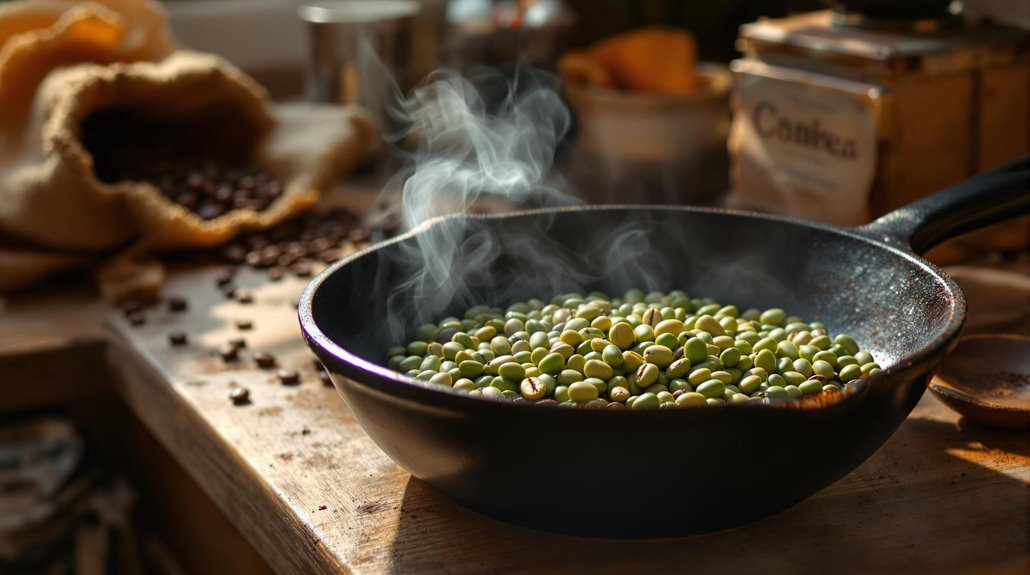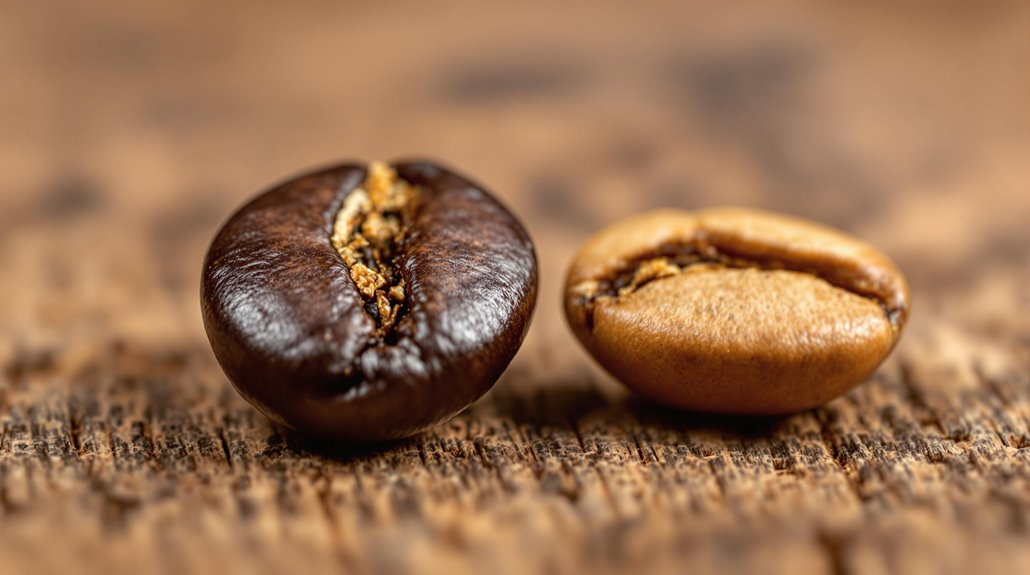







Storing coffee beans properly is key to preserving their flavor, but it's not as simple as tossing them in a cupboard. You'll want to avoid air, moisture, and light, which can quickly degrade their quality. While airtight containers are a must, not all storage methods are equal—some can even harm your beans. Freezing might seem like a solution, but it comes with risks if not done correctly. So, how do you strike the balance between convenience and freshness? The answer lies in understanding the science behind coffee storage and avoiding common pitfalls that could ruin your brew.
Key Takeaways
- Store coffee beans in opaque, airtight containers to block light and prevent oxidation.
- Keep beans at room temperature (60-75°F) in a cool, dark place like a pantry.
- Use containers with one-way degassing valves to allow CO2 release while blocking oxygen.
- Avoid freezing unless necessary; if freezing, use airtight, vacuum-sealed containers and thaw to room temperature before opening.
- Buy smaller quantities and consume within 2-4 weeks post-roast for peak freshness.
Optimal Storage Conditions for Coffee Beans
To preserve the quality of your coffee beans, store them in an opaque, airtight container at room temperature, ideally between 60-75°F (15-24°C). An opaque container blocks light, which can degrade the beans' flavor compounds, while an air-tight seal prevents oxygen from causing oxidation. Room temperature is critical because heat accelerates the breakdown of oils and aromas, so avoid placing your container near ovens, stoves, or sunny countertops. Containers with one-way valves are particularly effective, as they allow carbon dioxide, released by freshly roasted beans, to escape without letting oxygen in. This prevents pressure buildup while maintaining freshness. Always choose a cool, dark place for storage, such as a pantry or cupboard, to minimize exposure to fluctuating temperatures and light. Avoid clear or translucent containers, as they fail to protect against light exposure. Transfer your beans from their original packaging to a dedicated air-tight container, as retail bags often lack the necessary barrier to maintain long-term freshness. By following these guidelines, you'll guarantee your coffee beans retain their peak flavor and aroma for as long as possible.
Impact of Air, Moisture, and Light on Freshness
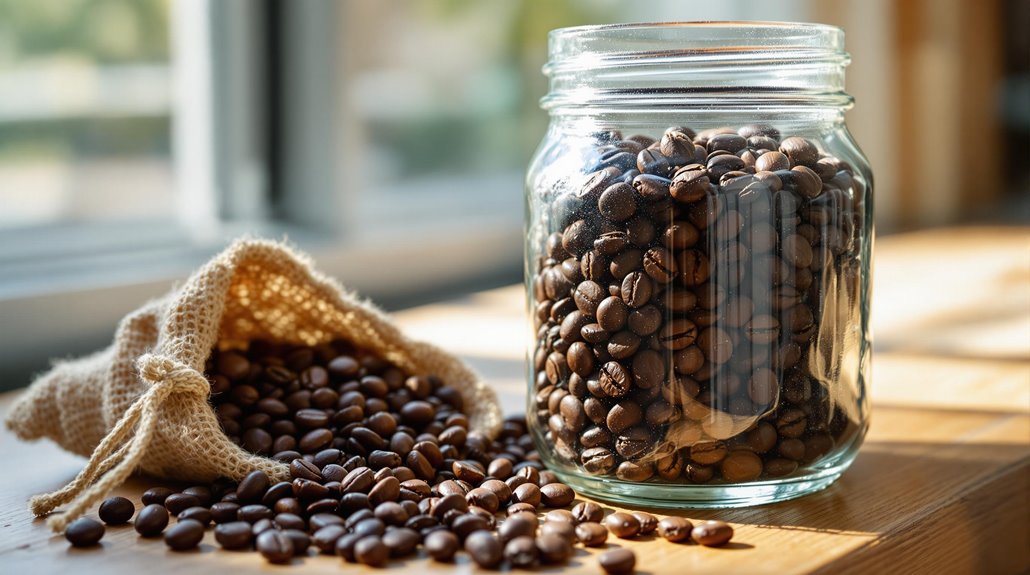
Oxygen exposure causes coffee to oxidize, leading to stale flavors and a loss of aromatic compounds. Moisture accelerates staling and promotes mold growth, particularly in environments with humidity levels above 60%. Light, especially sunlight, degrades coffee's chemical structure, resulting in flavor loss and faster aging.
Oxygen Exposure Risks
Over time, exposure to oxygen, moisture, and light can markedly degrade the quality of your coffee beans. Oxygen exposure is particularly harmful, as it triggers oxidation, a chemical reaction that leads to flavor loss and aroma degradation. When coffee beans come into contact with air, their volatile compounds break down, resulting in a stale or flat taste. To minimize this risk, store your coffee beans in airtight containers that limit oxygen exposure. These containers create a barrier against air, preserving the beans' freshness for up to 2-4 weeks post-roast. Alternatively, consider using one-way valve bags, which are specifically designed for coffee storage. These bags allow carbon dioxide, a natural byproduct of roasted beans, to escape while preventing oxygen from entering. This dual-action mechanism helps maintain the beans' quality by reducing oxidation. Avoid transferring beans to non-sealed containers, as even brief exposure to air can accelerate flavor deterioration. By prioritizing airtight storage solutions, you can notably extend the shelf life and preserve the complex flavors of your coffee beans.
Light and Moisture Effects
Light exposure and moisture levels are critical factors that can substantially impact the freshness and quality of your coffee beans. UV light breaks down the oils and aromatic compounds in coffee, leading to a loss of flavor and aroma. To prevent this, store your coffee beans in opaque or dark-colored containers that block light. Avoid clear or transparent packaging, as it allows light to penetrate and degrade the beans over time.
Moisture is equally detrimental to coffee beans, which are hygroscopic and absorb water and odors from the air. High humidity levels above 60% can cause beans to stale faster and even promote mold growth. Always store your coffee in a dry, cool environment, and use airtight containers to seal out moisture and air. Airtight storage not only preserves the beans' freshness but also protects their delicate flavor profile. By minimizing light and moisture exposure, you'll extend the shelf life of your coffee beans and maintain their ideal taste and aroma.
Freezing Coffee: Pros, Cons, and Best Practices
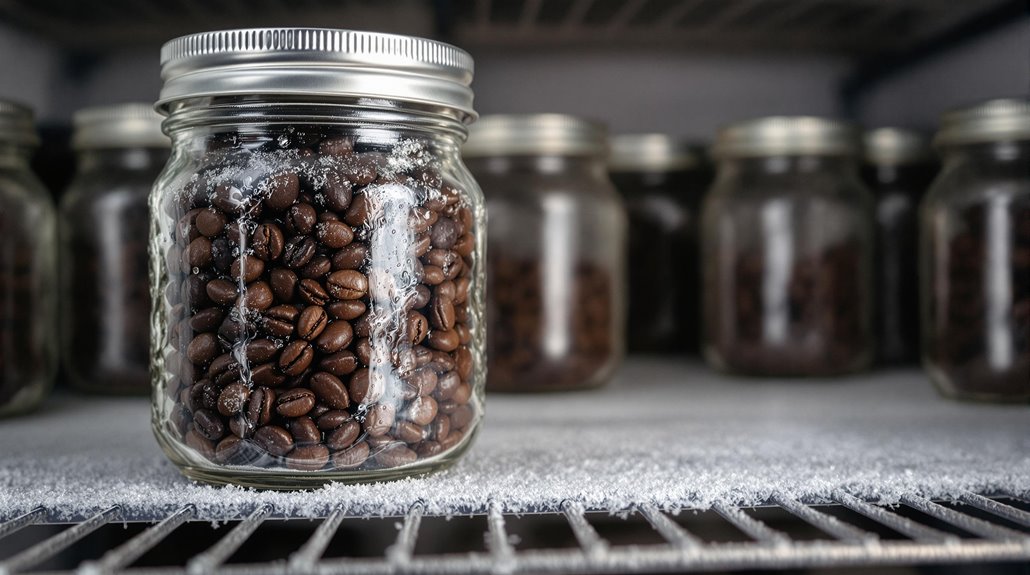
Freezing coffee beans can help preserve their freshness for up to a month, but it's crucial to do it right. To store beans in the freezer, use airtight, vacuum-sealed containers or bags to prevent moisture and odors from affecting the beans. Avoid frequent thawing and refreezing, as this can cause condensation to form inside the bag, degrading the beans' flavor and texture. For best results, divide your beans into small, single-use portions before freezing. This minimizes exposure to air when you retrieve them, helping to keep the remaining beans fresh.
When you're ready to use frozen beans, let them reach room temperature before opening the container. This prevents condensation from forming on the beans, which can compromise their quality. Freezing is particularly effective for long-term storage of specialty or bulk coffee, but it's not ideal for daily use. If you plan to use your beans regularly, store them in a cool, dark place instead. Properly frozen beans can retain their freshness, but improper handling can lead to flavor loss and texture changes.
Freshness Timeline and Degassing

After roasting, coffee beans undergo a process called degassing, where they release carbon dioxide (CO2). This post-roast phase is critical for achieving peak flavor, as excessive CO2 can cause bitterness and uneven extraction during brewing. For filter brews, freshness peaks between 2 days and 4 weeks post-roast, with the best flavor typically emerging around 7-10 days. Espresso beans, however, have a slightly longer freshness window, lasting 1 to 6 weeks post-roast, depending on the roast level. Darker roasts require more time to degas—up to 2 weeks—while lighter roasts degas faster and reach their flavor peak sooner. Roasters often include a "Roasted on" date to help you track freshness and consume within the ideal period. Proper degassing guarantees that the beans develop their full flavor profile, so avoid using them immediately after roasting. By understanding the degassing timeline and aligning your brewing with the roast date, you can maximize the freshness and flavor of your coffee.
Common Storage Mistakes and Maintenance Tips

To maintain the quality of your coffee beans, it's essential to steer clear of common storage errors that can jeopardize their flavor and freshness. Avoid storing coffee in grinder hoppers, as they expose whole beans to air and humidity, leading to staleness and oil buildup. Instead, transfer beans to airtight storage containers immediately after use. Leaving coffee in its original bag without proper sealing accelerates oxidation, causing flavor degradation. Overbuying coffee beans is another mistake; large quantities stored for extended periods lose freshness and aromatic compounds. Purchase only what you'll use within two weeks to keep your beans fresh. Regularly clean your coffee grinders to prevent oil residue from transferring stale flavors to fresh beans. Pre-ground coffee loses freshness faster due to increased surface area exposed to oxygen, so always grind whole beans just before brewing. By avoiding these pitfalls and maintaining proper coffee storage practices, you'll preserve the integrity and flavor of your beans.
Original Packaging and Airtight Storage

Original coffee packaging often features one-way gas-release valves that expel carbon dioxide while blocking oxygen, preserving freshness. If the original packaging is damaged or lacks proper sealing, transfer beans to an airtight, opaque container to minimize exposure to light and air. Avoid frequent transfers to maintain the gas-release functionality and prevent unnecessary degassing, which can compromise flavor.
Gas-Release Valve Functionality
Coffee bags equipped with one-way gas-release valves effectively manage the degassing process of freshly roasted beans. These valves allow carbon dioxide, a natural byproduct of roasting, to escape while preventing oxygen from entering the bag. This dual functionality guarantees the internal environment remains airtight, preserving the beans' freshness and flavor. The valve's design is critical—it balances the release of carbon dioxide without compromising the seal, which would otherwise expose the beans to oxygen and accelerate staling. High-quality original packaging with these valves often outperforms aftermarket containers, as it's specifically engineered to maintain the integrity of the beans during storage. By keeping oxygen out and allowing carbon dioxide to vent, the valve guarantees your coffee retains its ideal aroma and taste for longer. When you store beans in their original packaging, you're leveraging a system designed to protect against external contaminants while accommodating the natural degassing process. This makes the original packaging with a gas-release valve a superior choice for maintaining the freshness of your coffee beans.
Airtight Container Benefits
Airtight containers' primary advantage lies in their ability to block oxygen, a key factor in preserving coffee's flavor and aroma. Oxygen exposure accelerates oxidation, which degrades the oils and compounds responsible for coffee's rich taste. While original coffee bags often feature one-way valves that allow CO2 to escape while preventing air from entering, they may lack proper sealing mechanisms for long-term storage. This is where airtight canisters excel. High-quality options like Fellow Atmos or Airscape use vacuum-sealing technology to remove air, extending freshness for weeks. When transferring beans, make certain the container has a tight seal to prevent oxygen infiltration. Airtight storage also shields coffee from moisture and external odors, which can compromise its aroma and flavor. If your original packaging doesn't provide adequate protection, switching to an airtight canister is a practical solution. Look for containers with robust sealing mechanisms to maintain ideal conditions. By minimizing oxygen exposure, you preserve the delicate balance of coffee flavor, guaranteeing each brew retains its intended profile.
Degassing and Freshness Maintenance
After roasting, coffee beans release carbon dioxide—a process known as degassing—which is essential for maintaining freshness. To preserve this freshness, store your beans in their original packaging, which is specifically designed with one-way degassing valves. These valves allow carbon dioxide to escape while preventing oxygen from entering, guaranteeing the beans remain fresh and flavorful. The packaging also shields the beans from light and air, which can degrade quality over time.
If the original packaging is compromised or lacks proper sealing, transfer the beans to an airtight container with a gas-release valve. This minimizes exposure to air, moisture, and light, extending the beans' freshness. Avoid unnecessary transfers, as opening the container disrupts the natural degassing process and exposes the beans to oxygen. High-quality airtight containers with degassing valves can replicate the functionality of original packaging, but always prioritize containers that block light and maintain a tight seal. By managing degassing effectively and protecting your beans from external factors, you'll guarantee they retain their peak flavor and aroma for longer.
Freezer Storage and Temperature Considerations
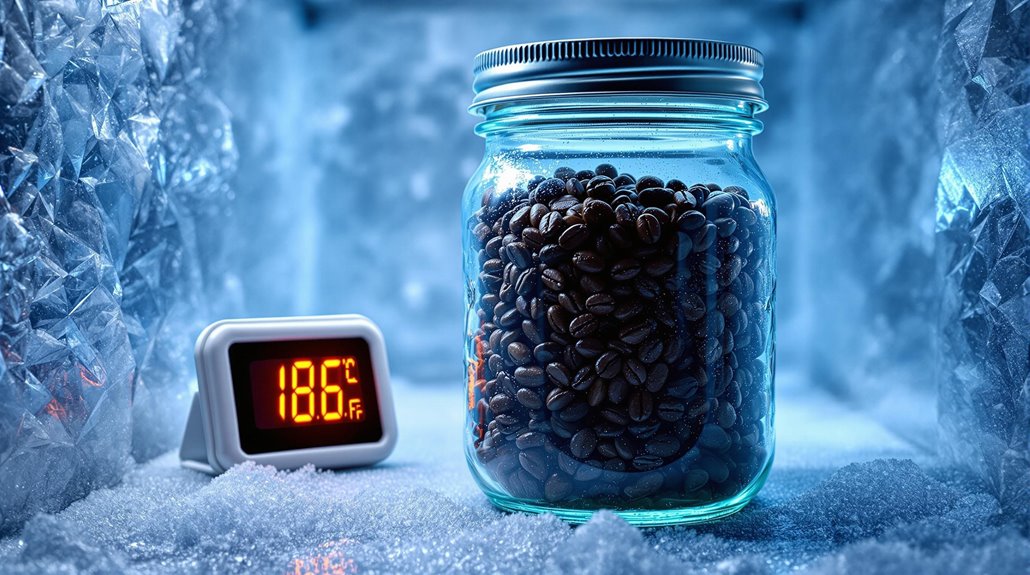
For long-term preservation, freezing coffee beans can help maintain freshness, but only under specific conditions. Store your coffee beans in an airtight, vacuum-sealed container to prevent moisture and odors from compromising their flavor. When you remove the beans from the freezer, let them reach room temperature before opening the container. This prevents condensation from forming, which can degrade the beans' quality and alter their flavor profile. Use a stand-alone freezer if possible, as it maintains a consistent temperature near 0ºF, ideal for long-term storage. Refrigerator freezers, which experience frequent temperature fluctuations, are less reliable for preserving coffee beans. Avoid refreezing thawed beans, as repeated temperature changes can lead to moisture buildup and flavor loss. Freezing is best suited for specialty or bulk coffee storage rather than daily use, as prolonged freezing can affect the beans' texture and flavor over time. By following these guidelines, you can extend the shelf life of your coffee beans while minimizing risks to their quality.
Optimal Consumption Timeline and Flavor Development
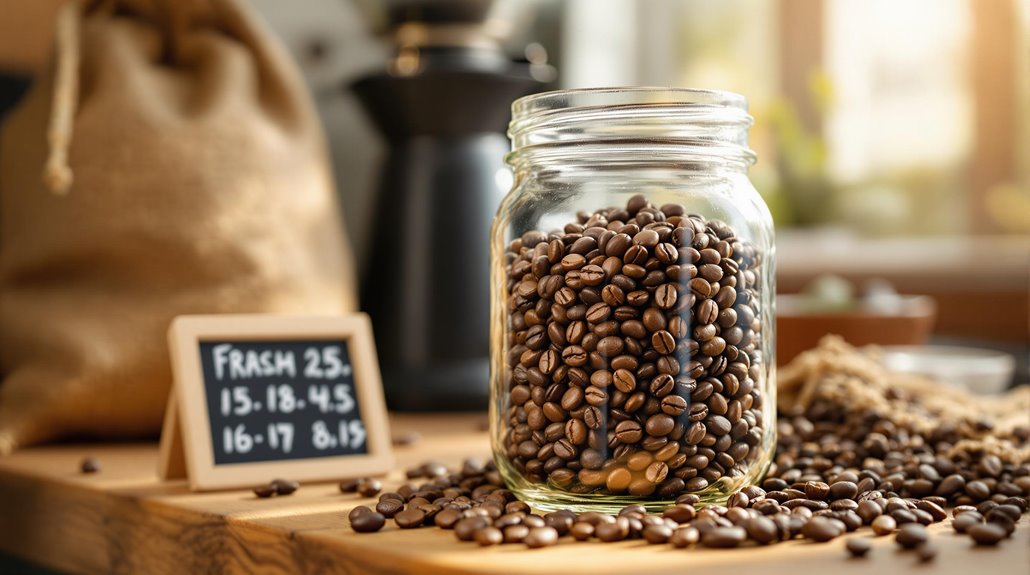
To maximize the flavor potential of your coffee, it's essential to grasp how its taste evolves over time. Whole bean coffee peaks in flavor between one day and two weeks post-roast, with subtle changes continuing for several months. However, nuanced flavors diminish after two weeks, so purchase smaller quantities you can consume within this window. This guarantees your coffee stays as fresh as possible. For espresso, allow beans to rest for five days post-roast to avoid salty flavors, while filter coffee is best brewed three to ten days after roasting. Since large quantities stored for months lose freshness, buy smaller amounts every two weeks to maintain consistent quality. The best way to store excess beans is in the freezer, which can extend freshness, but even frozen, flavor development continues over time, with subtle changes noticeable up to two months post-roast. By understanding these timelines and adjusting your purchasing habits, you'll enjoy coffee at its peak flavor.
Disclosure: As an Amazon Associate, I earn from qualifying purchases.




